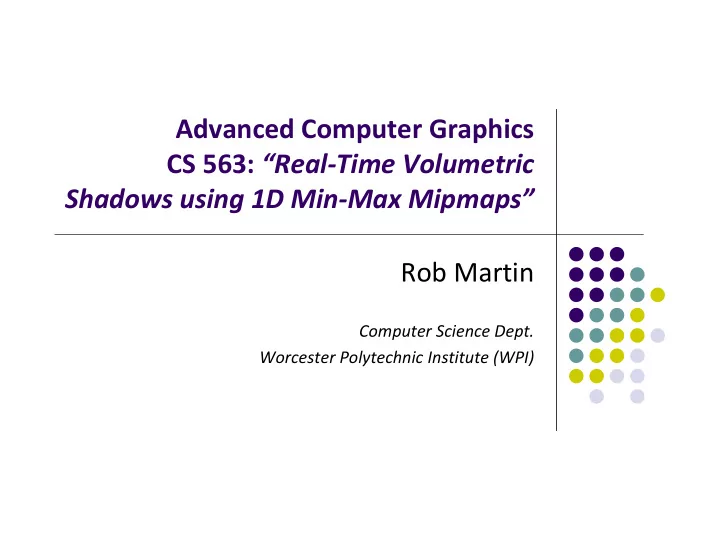

Advanced Computer Graphics CS 563: “Real ‐ Time Volumetric Shadows using 1D Min ‐ Max Mipmaps” Rob Martin Computer Science Dept. Worcester Polytechnic Institute (WPI)
Introduction We want to model the effects of light scattering in a participating medium Dust, moisture, etc. Difficult to do in real time since scattering occurs within a volume; i.e., all points along a camera ray This algorithm is an attempt at recreating this effect through the use of approximation techniques, epipolar shadow maps, min ‐ map mipmaps, and parallelism.
Introduction
Assumptions Use single ‐ scattering model [Blinn 1982] Approximates more complex physics Simple, realistic results Assume the scattering medium is homogeneously distributed.
Naïve approach: Ray marching Render shadow map from light source Shoot a ray from the camera for each pixel Walk down the ray at equal intervals from the camera to the first intersection Take sample at each interval Compute final radiosity from samples
Algorithm Overview Render depth map from the camera and a shadow map from the light source Perform ‘epipolar rectification’ on the shadow map Compute approximate scattering integral Build min ‐ max mipmaps from shadow map Traverse mipmaps for each camera ray to determine lit segments (If epipole is on or near screen, use ray marching
Single Scattering v : normalized direction vector d : distance to first occluder σ s : scattering coef. σ t : σ s - σ a extinction coef. V(s v ) : 1 if in light, 0 otherwise L in (s v ) : radience assuming no occusion ρ ( θ ) : scattering phase function
Epipolar Rectification Conversion from cartesian coordinate system to epipolar coordinates 3 ‐ dimensional space Every point has α , β , γ Camera rays are indexed by ( α , β ) Light rays by ( α , γ ) α determines the ‘slice’ Draw me
Epipolar Rectification, cont. To rectify the shadow map, rows are indexed by α , columns by γ ; each pixel contains the β Do not need to rectify the camera
Revamped Scattering Integral D( α , β ) : the γ coordinate where the camera ray hits the first occluder
Integral approximations The I term is too complex to compute, so approximate by sampling in a 64x64 grid Approximate integral in equation 5 by using a Riemann sum; integrate in the visibility term (V)
Textured Lights To enable textured lights, must also rectify the texture map New texture coordinates given by T( α , γ ) Must compute prefix sums of Γ i ( γ )T( α , γ ) Must do this for each α
1D Min ‐ Max Mipmaps Binary tree structure Each node holds the minimum and maximum value of all child nodes Each row of the rectified shadow map corresponds to an α slice in epipolar coordinates Create a min ‐ max mipmap for each row/slice
Min ‐ Max Mipmaps, cont. Use the mipmaps to quickly find lit/unlit areas of the camera ray For a ray with angle β , if β is less than minimum, then the area is lit. If greater than the maximum, the area is in shadow.
Parallelism With the rectified shadow maps, min ‐ max mipmaps, and precomputed scattering integrals, each camera ray can be computed in parallel on a fragment/pixel shader Key for algorithm performance
Results
Results, cont. Incremental integration is a very similar algorithm Main difference is the data structure used to detect lit/unlit areas Uses a dynamic data structure called a partial sum tree Is not static, nor is it parallelizable
Limitations Homogeneous scattering medium Anisotropic mediums mess up the integral approximations Shadow maps are susceptible to aliasing Must brute force near the epipole
Conclusions Effective real ‐ time algorithm for producing the effect of shadow volumes and participating medium Mathematical techniques simplify computations by pre ‐ computing static values used in the integration Simplified data structure allows for parallism Algorithm can run on most hardware (DX9)
References Blinn, J. F. 1982. Light re fl ection functions for simulation of clouds and dusty surfaces. 21–29 Jiawen Chen, Ilya Baran, Fredo Durand, Wojciech Jarosz. Real ‐ Time Volumetric Shadows using 1D Min ‐ Max Mipmaps . Proceedings of the 2011 Symposium on Interactive 3D Graphics and Games, 2011.
Recommend
More recommend